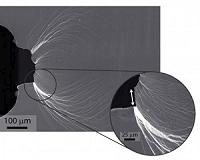 |
Troy NY (SPX) Jan 11, 2011 A few unassuming drops of liquid locked in a very precise game of "follow the leader" could one day be found in mobile phone cameras, medical imaging equipment, implantable drug delivery devices, and even implantable eye lenses. Engineering researchers at Rensselaer Polytechnic Institute have developed liquid pistons, in which oscillating droplets of ferrofluid precisely displace a surrounding liquid. The pulsating motion of the ferrofluid droplets, which are saturated with metal nanoparticles, can be used to pump small volumes of liquid. The study also demonstrated how droplets can function as liquid lenses that constantly move, bringing objects into and out of focus. These liquid pistons are highly tunable, scalable, and - because they lack any solid moving parts - suffer no wear and tear. The research team, led by Rensselaer Professor Amir H. Hirsa, is confident this new discovery can be exploited to create a host of new devices ranging from micro displacement pumps and liquid switches, to adaptive lenses and advanced drug delivery systems. "It is possible to make mechanical pumps that are small enough for use in lab-on-a-chip applications, but it's a very complex, expensive proposition," said Hirsa, a professor in the Department of Mechanical, Aerospace, and Nuclear Engineering at Rensselaer. "Our electromagnetic liquid pistons present a new strategy for tackling the challenge of microscale liquid pumping. Additionally, we have shown how these pistons are well-suited for chip-level, fast-acting adaptive liquid lenses." Results of the study are detailed in the paper "Electromagnetic liquid pistons for capillarity-based pumping," recently published online by the journal Lab on a Chip. The paper will be featured on the cover of the journal's February 2011 issue, and can be read online. Hirsa's team developed a liquid piston that is comprised of two ferrofluid droplets situated on a substrate about the size of a piece of chewing gum. The substrate has two holes in it, each hosting one of the droplets. The entire device is situated in a chamber filled with water. Pulses from an electromagnet provoke one of the ferrofluid droplets, the driver, to vibrate back and forth. This vibration, in turn, prompts a combination of magnetic, capillary, and inertial forces that cause the second droplet to vibrate in an inverted pattern. The two droplets create a piston, resonating back and forth with great speed and a spring-like force. Researchers can finely control the strength and speed of these vibrations by exposing the driver ferrofluid to different magnetic fields. In this way, the droplets become a liquid resonator, capable of moving the surrounding liquid back and forth from one chamber to another. Similarly, the liquid piston can also function as a pump. The shift in volume, as a droplet moves, can displace from the chamber an equal volume of the surrounding liquid. Hirsa said he can envision the liquid piston integrated into an implantable device that very accurately releases tiny, timed doses of drugs into the body of a patient. As the droplets vibrate, their shape is always changing. By passing light through these droplets, the device is transformed into a miniature camera lens. As the droplets move back and forth, the lens automatically changes its focal length, eliminating the usual chore of manually focusing a camera on a specific object. The images are captured electronically, so software can be used to edit out any unfocused frames, leaving the user with a stream of clear, focused video. The speed and quality of video captured from these liquid lenses has surpassed 30 hertz, which is about the quality of a typical computer web cam. Liquid lenses could mean lighter camera lenses that require only a fraction of the energy demanded by today's digital cameras. Along with handheld and other electronic devices, and homeland security applications, Hirsa said this technology could even hold the key to replacement eye lenses that can be fine-tuned using only high-powered magnets. "There's really a lot we can do with these liquid pistons. It's an exciting new technology with great potential, and we're looking forward to moving the project even further along," he said. Along with Hirsa, co-authors on the paper are Rensselaer doctoral graduates Bernard Malouin Jr., now with MIT's Lincoln Laboratory; and Michael Vogel, a private research consultant; Rensselaer mechanical engineering doctoral student Joseph Olles; and former postdoctoral researcher Lili Cheng, now with General Electric Global Research.
Share This Article With Planet Earth
Related Links Rensselaer Polytechnic Institute Space Technology News - Applications and Research
 New Glass Tops Steel in Strength and Toughness
New Glass Tops Steel in Strength and ToughnessBerkeley, Germany (SPX) Jan 11, 2011 Glass stronger and tougher than steel? A new type of damage-tolerant metallic glass, demonstrating a strength and toughness beyond that of any known material, has been developed and tested by a collaboration of researchers with the U.S. Department of Energy (DOE)'s Lawrence Berkeley National Laboratory (Berkeley Lab)and the California Institute of Technology. What's more, even better versions of ... read more |
|
| The content herein, unless otherwise known to be public domain, are Copyright 1995-2010 - SpaceDaily. AFP and UPI Wire Stories are copyright Agence France-Presse and United Press International. ESA Portal Reports are copyright European Space Agency. All NASA sourced material is public domain. Additional copyrights may apply in whole or part to other bona fide parties. Advertising does not imply endorsement,agreement or approval of any opinions, statements or information provided by SpaceDaily on any Web page published or hosted by SpaceDaily. Privacy Statement |